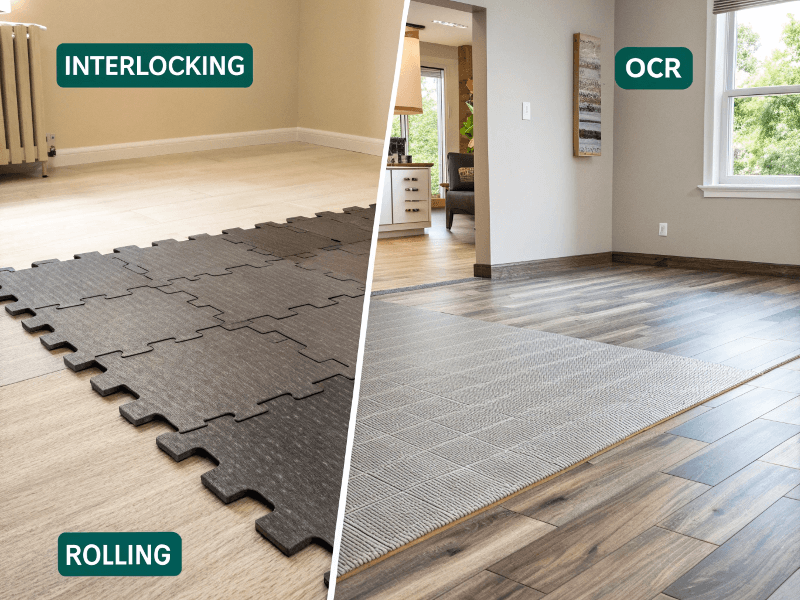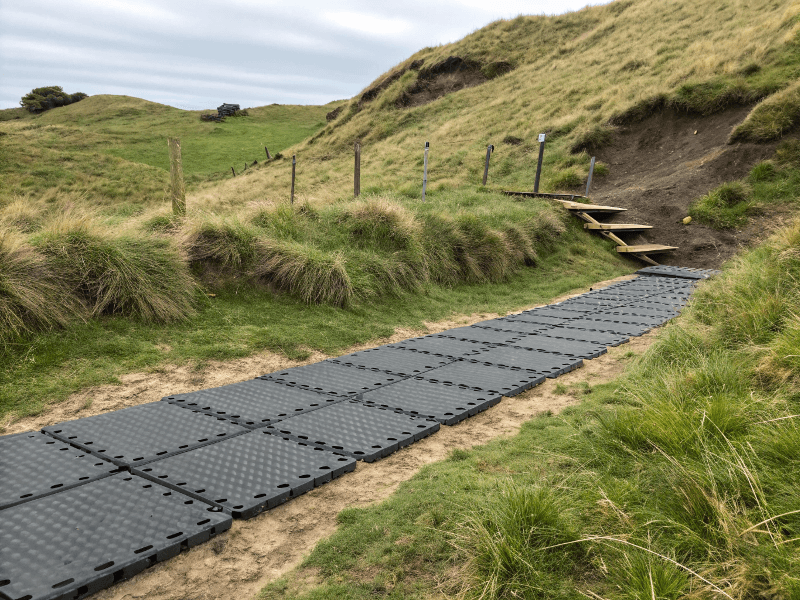يجب أن تتفوق أفضل أرضيات منافسات التعرف الضوئي على الحروف في ثلاثة مجالات: سرعة النشر للتركيبات المؤقتة، والمتانة في جميع الأحوال الجوية للتعامل مع أي ظروف، والقدرة على التكيف للتركيب على أرض معقدة وغير مستوية. يضمن الحصول على هذا الاختيار الصحيح السلامة والتحكم في التكاليف وتحسين كفاءة الفعاليات.
بصفتي مشرفًا على مراقبة الجودة، رأيت عددًا لا يحصى من منظمي الفعاليات، "الأبطال المؤقتين"، يواجهون التحدي الهائل المتمثل في بناء مضمار سباق عالمي المستوى في حقل أو موقف سيارات أو على الشاطئ. الأرضية التي تختارها هي أساس الحدث بأكمله. يجب أن تكون محمولة بما يكفي لإعدادها بسرعة، وقوية بما يكفي لتتحمل أي طقس، ومتعددة الاستخدامات بما يكفي لتناسب التضاريس غير المثالية. يستند هذا الدليل على سنوات خبرتي في فحص هذه التجهيزات ورؤية ما يصلح وما يفشل تحت الضغط. وسوف يساعدك على اختيار حل الأرضيات الذي يحمي الرياضيين وميزانيتك وسمعة علامتك التجارية.

اختيار الأساس الصحيح هو الخطوة الأولى لنجاح الفعالية. والآن، سننظر في العامل الوحيد الأكثر أهمية لأي منظم فعاليات مؤقتة: الكفاءة. فالسرعة وقابلية النقل ليستا مجرد وسائل راحة؛ فهما مرتبطان بشكل مباشر بأرباحك النهائية. دعنا نفحص كيف تؤثر أنواع الأرضيات المختلفة على وقت الإعداد وتكاليف العمالة.
لماذا تُعد قابلية النقل وسرعة التركيب عاملاً مغيراً لقواعد اللعبة بالنسبة لأرضيات OCR؟
إن قابلية النقل والسرعة أمران مهمان للغاية لأنهما يخفضان تكاليف العمالة بشكل مباشر ويختصران الجدول الزمني للمشروع. يوفر البلاط المتشابك مرونة في التخطيطات المعقدة، في حين أن الأرضيات المدرفلة الكبيرة يمكن أن تغطي مساحات كبيرة ومسطحة بسرعة كبيرة. يؤثر اختيارك بشكل كبير على كفاءة الإعداد والميزانية.
في عالم التخطيط للفعاليات، الوقت هو المال. لقد رأيت طواقم العمل تكافح لأيام مع المواد الثقيلة والمرهقة، مما يؤدي إلى زيادة تكاليف العمالة ودفع الجداول الزمنية إلى حافة الهاوية. تُعد كفاءة عملية تركيب الأرضيات وإزالتها عاملاً رئيسياً في ربحية فعاليتك. أنت بحاجة إلى نظام سريع ومباشر ولا يتطلب فريق عمل كبير ومتخصص. وهنا يأتي دور النقاش بين الأرضيات المتشابكة والأرضيات المدرفلة.
البلاط المتشابك: الإيجابيات والسلبيات
البلاط المتشابك هو بطل المرونة. أنا أفضلها لمعظم تطبيقات التعرف الضوئي على الحروف لأنها تتكيف بشكل جيد مع الأشكال غير المنتظمة حول العوائق أو مناطق التجهيز. إذا تعرضت إحدى القطع للتلف، يمكنك فقط تبديل بلاطة واحدة بدلاً من استبدال جزء كامل. قد يكون عيبها الرئيسي هو وقت التركيب الأولي، حيث يتم وضعها قطعة قطعة. ولكن نظام القفل الجيد، الآمن وسهل التوصيل في نفس الوقت، يُحدث فرقاً كبيراً.
الأرضيات المدرفلة: الإيجابيات والسلبيات
تبدو الأرضيات المدرفلة سريعة، وهي كذلك في مساحة كبيرة ومسطحة تماماً مثل قاعة المؤتمرات. ولكن بالنسبة لفعاليات التعرف الضوئي على الحروف في الهواء الطلق، فإنها تمثل مشاكل. فاللفائف ثقيلة وضخمة بشكل لا يصدق وتتطلب المزيد من القوى العاملة والآلات لنقلها. كما أن قطعها لتناسب العوائق أمر صعب ومهدر. ومن واقع خبرتي، فإن المشاكل اللوجستية غالباً ما تفوق فوائد السرعة في مسار سباق التعرف على الحواجز المتنوع. قد ينجح النهج المركب، ربما باستخدام الحصائر الملفوفة فقط لخط النهاية الطويل والمستقيم على الرصيف، لكن البلاط يوفر مزايا أكثر اتساقاً.

أرضياتك في الموقع وطاقمك جاهز للعمل. ولكن بعد ذلك تتغير توقعات الطقس. لا فائدة من التجهيز السريع إذا تحول مضمارك إلى مستنقع أو صفيح ساخن عندما يتغير الطقس. يجب أن تكون أرضياتك جاهزة لأي شيء ترميه الطبيعة الأم، لتحمي الرياضيين والفعالية الخاصة بك.
كيف يمكن لأرضيات OCR أن تتحمل أي ظروف جوية؟
تحمي أرضيات OCR المناسبة لجميع الأحوال الجوية الرياضيين من خلال التحكم في الماء والحرارة والبرودة. يجب أن تكون ذات تصريف ممتاز لمنع الانزلاق في المطر، ومقاومة للأشعة فوق البنفسجية لتبقى باردة وسليمة في الشمس، ومرنة لتجنب التشقق في درجات الحرارة المتجمدة.
دائماً ما تكون الفعاليات الخارجية تحت رحمة الطقس. بصفتي مشرفاً، أعتبر أن قدرة الأرضيات على التكيف مع الطقس هي ميزة السلامة الأساسية. يمكن أن يؤدي هطول أمطار غزيرة مفاجئة أو موجة حر غير متوقعة إلى تحويل فعالية رائعة إلى فعالية خطيرة إذا لم يكن سطح الأرض مهيأً للتعامل معها. يجب أن تكون أرضيتك درعًا وليس خطرًا آخر.
تحدي المياه: التصريف الفائق
لقد أشرفتُ ذات مرة على حدث حيث ضربت عاصفة رعدية مفاجئة. تحوّل الموقع ذو الأرضيات الرخيصة ذات السطح الصلب على الفور إلى سلسلة من برك المياه الزلقة والخطيرة. أما المنطقة المجاورة ذات الأرضيات المثقوبة ذات التصميم المفتوح من البلاط، فقد تم تصريف المياه منها على الفور تقريبًا. مرت المياه مباشرة من خلالها، مما منع الوحل وحافظ على ثبات السطح. هذا أمر غير قابل للتفاوض بالنسبة لـ OCR. ابحث عن أرضيات ذات قنوات تصريف مدمجة أو تصميم مثقوب لضمان عدم تحول المياه إلى خطر الانزلاق.
تحدي الحرارة: مقاومة أشعة الشمس والأشعة فوق البنفسجية
يمكن أن تسبب الشمس المباشرة مشكلتين كبيرتين. أولاً، يمكن أن تصبح المواد الداكنة والكثيفة ساخنة بشكل خطير، مما يشكل خطر الحروق على الرياضيين. ثانياً، تعمل الأشعة فوق البنفسجية (UV) على تكسير المواد بمرور الوقت، مما يؤدي إلى تلاشيها وهشاشتها وتشوهها. أوصي دائماً بالأرضيات المصنوعة من البوليمرات مع مثبتات الأشعة فوق البنفسجية عالية الجودة. وهذا يضمن بقاء المادة أكثر برودة عند اللمس، واحتفاظها بلونها، وعدم تشوهها أو تجعدها عند الحواف بعد ساعات من التعرض لأشعة الشمس الحارقة.
تحدي البرد: منع التشققات
بالنسبة للأحداث في المناخات الباردة أو على ارتفاعات عالية، فإن أداء المواد في درجات الحرارة المنخفضة هو المفتاح. يمكن أن تصبح المواد البلاستيكية الأرخص ثمناً هشة للغاية في البرد. لقد رأيتها تتشقق وتتحطم تحت وطأة وزن الرياضيين أو المعدات، مما يؤدي إلى ظهور حواف حادة وخطيرة. أنت بحاجة إلى اختيار أرضية مصنوعة من مزيج بوليمر عالي الجودة يحافظ على مرونته ومقاومته للصدمات حتى عندما تنخفض درجة الحرارة، مما يضمن السلامة في أي موسم.

لقد عثرت على نظام أرضيات سريع التركيب وجاهز لأي طقس. ولكن لا يوجد ملعب مثالي ومسطح لفعاليتك. سوف تقوم بالتركيب على عشب وعر أو رمال رخوة أو أرضيات أسفلتية متشققة. الاختبار النهائي لنظام الأرضيات الرائع هو قدرته على التغلب على هذه الأسطح غير المثالية.
هل يمكن وضع أفضل أرضيات OCR مباشرة على أرض غير مستوية؟
نعم، أفضل أرضيات OCR المعيارية مصممة خصيصاً لتوضع على أرض غير مستوية. تسمح لها مرونتها المتأصلة بالتوافق مع منحنيات الأسطح مثل العشب والتراب والرمال، بينما يحافظ نظام التشابك القوي على اتصال البلاط بإحكام.
إن العثور على موقع مستوٍ وسلس تماماً لفعالية مؤقتة هو رفاهية لا يملكها إلا القليل من المنظمين. والحقيقة أنك ستعمل بما يمكنك الحصول عليه. وهذا هو المكان الذي تثبت فيه الأرضيات المناسبة قيمتها. أنت بحاجة إلى سطح يمكنه التعامل مع العالم الحقيقي، وليس سطحاً يتطلب أرضية سفلية معدة بشكل مثالي. وتوفر هذه القدرة على التكيف كميات هائلة من الوقت والمال على إعداد الأرضية.
الحد الأدنى من المتطلبات الأرضية
من وجهة نظري الخاصة بمراقبة الجودة، فإن "تسامح" نظام الأرضيات هو مؤشر رئيسي للأداء. يمكن وضع نظام البلاط المتشابك المتفوق مباشرةً فوق العشب الوعر قليلاً أو التراب الصلب أو حتى الرمال بأقل قدر من التجهيزات. لقد رأيت فعاليات ناجحة تم بناؤها على بعض التضاريس الصعبة للغاية. ويكمن السر في مدى مرونة البلاط الفردي وترابطه. فهي تخلق سطحاً مستقراً ومستمراً "يطفو" فوق العيوب البسيطة ويخفيها عن الرياضيين ويوفر مساراً آمناً ومتسقاً. وهذه ميزة هائلة مقارنةً بالحصائر الصلبة أو السلع المدرفلة التي قد تهتز أو تتحرك أو تخلق فجوات خطيرة على نفس السطح.
الدور الحاسم لنظام التشابك في النظام المتشابك
آلية القفل هي قلب النظام عند استخدامه على أرض غير مستوية. فبينما يركض آلاف الرياضيين ويقفزون على السطح، تتعرض كل نقطة اتصال للضغط. سيؤدي القفل الضعيف إلى انفتاح القفل، مما يخلق خطر التعثر الفوري. أفحص دائماً تصميم القفل عن كثب. أبحث عن نظام توصيل قوي متعدد النقاط مصمم للثبات تحت الضغط الرأسي والأفقي. وهذا يضمن بقاء الأرضية بأكملها سطحاً واحداً وموحداً حتى في الملاعب الوعرة، مما يوفر الأمان والثبات الذي تتطلبه فعاليتك.

لقد فهمت الآن الركائز الثلاث لأرضيات التعرف الضوئي على الحروف الرائعة. لاتخاذ قرارك النهائي، تحتاج إلى طرح الأسئلة الصحيحة على الموردين. لقد أعددت قائمة مرجعية تستند إلى سنوات من فحص المنتجات. سيساعدك هذا على تجاوز التسويق والوصول إلى البيانات المهمة.
ما هي قائمة المراجعة النهائية لاختيار مورد أرضيات OCR؟
تضمن لك قائمة المراجعة النهائية هذه أن تطلب من الموردين دليلاً محدداً مدعوماً بالبيانات على الأداء. ركز على سرعة التركيب، ولوجستيات النقل، والمتانة المختبرة، والقدرات المعتمدة في جميع الأحوال الجوية، والقدرة على التكيف على الأرض للقيام باستثمار مستنير حقاً.
عندما تتحدث إلى مورد محتمل، يجب أن تكون مستعداً. وبصفتي مشرفاً على مراقبة الجودة، لا أعتمد أبداً على الادعاءات الغامضة؛ فأنا أطالب بالتفاصيل. قائمة المراجعة هذه هي أداتك للقيام بالمثل. وهي مصممة لتزويدك ببيانات الأداء الواقعية التي تحتاجها لمقارنة المنتجات بدقة واختيار شريك أرضيات يمكنك الوثوق به.
| الفئة | الأسئلة الرئيسية التي يجب طرحها على المورد | ما أهمية ذلك |
|---|---|---|
| التركيب وقابلية النقل | ما هو وزن وحجم البلاط/البطانة الواحدة؟ هل يمكن لشخص واحد تركيبها؟ ما هو متوسط وقت التركيب لكل 100 متر مربع؟ | يؤثر ذلك بشكل مباشر على تكاليف العمالة والخدمات اللوجستية والجدول الزمني للإعداد. أنت بحاجة إلى أرقام، وليس فقط "سريع وسهل". |
| المتانة وقابلية إعادة الاستخدام | ما هي فترة الضمان؟ هل يمكنك تقديم بيانات من اختبارات البلى والتلف والتحميل؟ مما صنعت؟ | الضمان هو مقياس لثقة الشركة المصنعة. تثبت البيانات الثابتة قدرة المنتج على تحمل الاستخدام المتكرر. |
| الأداء في جميع الأحوال الجوية | ما هو نطاق درجة حرارة التشغيل الآمنة المختبرة؟ هل يمكنك توفير معدل تصريف المياه؟ هل يحتوي على مثبطات الأشعة فوق البنفسجية؟ | هذه مسألة سلامة حرجة. تحتاج إلى دليل على أنها لن تسخن بشكل خطير أو تتشقق في البرد أو تصبح زلقة. |
| قابلية الموقع للتكيف | ما هو الحد الأقصى لفرق الارتفاع الذي يمكن أن تتحمله الأرضيات على الأرضية الفرعية؟ ما نوع نظام القفل الذي تستخدمه؟ | هذا يخبرك كم من الوقت سيتعين عليك القيام بإعداد الموقع (أو عدم القيام به). القفل القوي ضروري للسلامة على أرض غير مستوية. |
اعتبر قائمة المراجعة هذه بمثابة فحص ما قبل الشراء. لقد رأيت منظمين يوفرون الآلاف من خلال طرح هذه الأسئلة مقدمًا. المورد الجيد سيكون لديه إجابات جاهزة وتقارير اختبار تدعمها. المورد الذي لا يستطيع الإجابة على هذه الأسئلة هو علامة حمراء. اذهب إلى محادثتك التالية وأنت مستعد، وستجد منتجًا يعمل حقًا.
إذا كنت مستعداً للعثور على أرضيات تجتاز هذا الفحص الدقيق، فإن فريقي هنا لمساعدتك. نحن نؤمن بتوفير البيانات التي تدعم وعودنا. يمكنك الاتصال بنا للحصول على عرض أسعار مباشر وحتى الحصول على عينات مجانية لتختبرها بنفسك.
الخاتمة
يعتمد اختيار الأرضية المناسبة لسباق التعرف على الحروف على ثلاث ركائز: قابلية النقل، والأداء في جميع الأحوال الجوية، والقدرة على التكيف مع الأرض. يُعد الاستثمار الصحيح ضماناً حاسماً لعلامتك التجارية وميزانيتك ورياضييك.

![17498022585521[1]](https://meettfit.com/wp-content/uploads/2025/06/174980225855211.jpg)